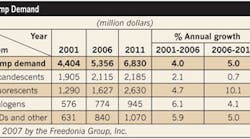Growth in nonresidential construction and the shift to more efficient and more expensive lighting technologies will drive growth in demand for lamps at an annual rate of 5% for the next four years (Table), according to the Freedonia Group Inc., Cleveland, in a recent report. The market research firm's forecast calls for lamp sales to reach $6.8 billion in 2011, up from $5.4 billion in 2006.
“Growth will be driven by a shift in product mix away from inexpensive incandescent lamps toward more expensive, energy-efficient lamps such as compact fluorescents (CFLs),” the firm said. “Strong nonresidential building construction activity through 2011 will bolster demand for lamps.”
However, the firm expects the switch to longer-lived lamps such as CFLs will dampen replacement demand over the longer term.
Among major product types, fluorescent lamps and primarily CFLs will show the largest gains, overtaking incandescents in value, though not in unit terms. Freedonia expects sales of fluorescent lamps to grow at a 10% annual rate through 2011. CFL sales will benefit from being an alternative to certain types of incandescents subject to federal restrictions, but will face competition from light-emitting diode (LED) lighting and “next-generation” incandescents/halogens designed to be more energy efficient.
Although demand for incandescents will decline, sales of the lamps will continue to make up a significant part of the lamp market because of the sheer size of the existing demand base, particularly in residential uses, Freedonia said. Incandescent lamp sales are expected to grow at an annual rate of 0.7% over the four-year period.
This article was originally published in the Dec. 7, 2007 edition of EC&M's sister publication, Electrical Marketing.




